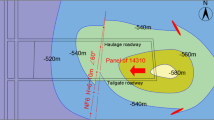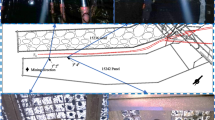Abstract
Computer simulation technology is more and more used in engineering. The simulation quality is directly related to the model used in the numerical calculation. The more model matches, the more realistic simulation results. Based on the double-sided shear test, a model of fault rock was proposed to describe the nonlinear characteristics of the surrounding rock during fault slip, the displacement evolution and stress drop of the surrounding rock during different loading stages were obtained. The model was applied in computer numerical simulation to discuss the law of fault rock activity. Simulation results show that, the destabilizing sliding process had two stages, deformation accumulation and abrupt dislocation. The deformation accumulation stage can be divided into three subprocesses: decelerating sliding, steady sliding, and accelerating sliding. When friction is added to a modified Kelvin model, which introduced a nonlinear hardening function and considered nonlinear damage in the accelerating sliding phase, the model produces a stress drop when the friction threshold is reached, so as to describe the characteristics of displacement of the fault rock, which can provide a theoretical basis for the study of fault slip instability mechanisms and deformation characteristics.






Similar content being viewed by others
References
Moore, D. E., Lockner, D. A., & Hickman, S. (2016). Hydrothermal frictional strengths of rock and mineral samples relevant to the creeping section of the San Andreas Fault. Journal of Structural Geology, 89, 153–167.
Richard, J., Gratier, J. P., Doan, M. L., et al. (2014). Rock and mineral transformations in a fault zone leading to permanent creep: Interactions between brittle and viscous mechanisms in the San Andreas Fault. Journal of Geophysical Research: Solid Earth, 119(11), 8132–8153.
Rutqvist, J., Rinaldi, A. P., Cappa, F., et al. (2015). Modeling of fault activation and seismicity by injection directly into a fault zone associated with hydraulic fracturing of shale–gas reservoirs. Journal of Petroleum Science and Engineering, 127, 377–386.
Jiang, Y. D., Wang, T., Zhao, Y. X., et al. (2013). Numerical simulation of fault activation pattern induced by coal extraction. Journal of China University of Mining & Technology, 42(1), 1–5.
Rutqvist, J., Rinaldi, A. P., Cappa, F., et al. (2016). Fault activation and induced seismicity in geological carbon storage—Lessons learned from recent modeling studies. Journal of Rock Mechanics and Geotechnical Engineering, 8(6), 789–804.
Yoon, J. S., Zimmermann, G., Zang, A., et al. (2015). Discrete element modeling of fluid injection-induced seismicity and activation of nearby fault. Canadian Geotechnical Journal, 52(10), 1457–1465.
Wang, L. G., & Miao, X. (2006). Numerical simulation of coal floor fault activation influenced by mining. Journal of China University of Mining and Technology, 16(4), 385–388.
Bao, X., & Eaton, D. W. (2016). Fault activation by hydraulic fracturing in western Canada. Science, 354(6318), 1406–1409.
Zhang, R., Jiang, Z., Zhou, H., et al. (2014). Groundwater outbursts from faults above a confined aquifer in the coal mining. Natural Hazards, 71(3), 1861–1872.
Wang G, Wu M, Wang R, et al. (2017). Height of the mining-induced fractured zone above a coal face. Engineering Geology, 216, 140–152.
Gan, Q., & Elsworth, D. (2014). Analysis of fluid injection-induced fault reactivation and seismic slip in geothermal reservoirs. Journal of Geophysical Research: Solid Earth, 119(4), 3340–3353.
Acknowledgements
This work is supported by State Key Research Development Program of China (Grant No. 2016YFC0801403), National Natural Science Foundation for Young Scientists of China (Grant No. 51504015), Open Projects of State Key Laboratory of Coal Resources and Safe Mining CUMT (Grant No. SKLCRSM15KF02), Fundamental Research Funds for the Central Universities (Grant No. FRF-TP-17-026A2), CSC (201706465004).
We thank Anika B. Newell, from Liwen Bianji, Edanz Group China (www.liwenbianji.cn/ac), for editing the English text of a draft of this manuscript.
Author information
Authors and Affiliations
Corresponding author
Rights and permissions
About this article
Cite this article
Wang, T. Numerical Simulation Model of Mining-Induced Fault Reactivation. Wireless Pers Commun 102, 1327–1336 (2018). https://doi.org/10.1007/s11277-017-5197-9
Published:
Issue Date:
DOI: https://doi.org/10.1007/s11277-017-5197-9




